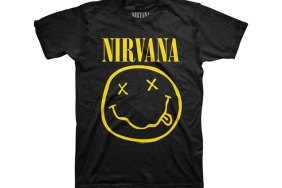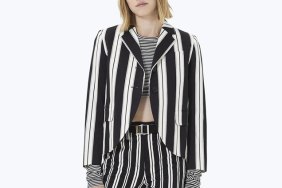The Chase-Catalano image teases a slideshow about the comeback of grunge style. Even though more than a couple runway designers (Marc by Marc Jacobs, Mark Fast, Timo Weiland, Rebecca Taylor) pulled from the slackerish nineties aesthetic for their Fall 2012 collections, WWD mostly chose to profile grungey offerings from smaller labels like Pas de Calais, Bullets to Bandages, and Cheap Monday — hipster brands. It should come as a surprise to absolutely no one that many young “downtown types” wear a lot of flannel.
WWD mixes some iconic “grunge style” moments in with the contemporary looks: the aforementioned MSCL pic, with Leto and Danes working “the grunge look to perfection;” Marc Jacobs‘ Fall 1993 Perry Ellis collection, which got him fired; Kurt Cobain‘s 1993 Unplugged appearance, to which he audaciously wore a “thrift-store cardigan.”
And here’s where we arrive at the real reason WWD thinks its grunge comeback slideshow should be one of the day’s top stories: even though it’s never mentioned in the captions, today marks the 18th anniversary of Kurt Cobain’s suicide. (Also, it’s the 10th anniversary of the death of another major grunge figure: Alice in Chains lead singer Layne Staley died from an overdose on April 5, 2002.) Even though WWD never states it explicitly, the slideshow is a perverse tribute to Kurt Cobain’s fashion legacy.
Cobain’s thrift-store cardigans were a statement against the fashion industry, and he was an unwilling style icon. Designers co-opted his protest and commodified it, marketing a high-fashion version of the Seattle music scene’s anti-fashion aesthetic to young people, at exorbitant prices. Fashion’s trendification of grunge was a complete violation of the genre’s central values, which were opposed to anything mainstream and commercial. The fashion industry is always yammering on and on about its willingness to be provocative, to go there, as evidence of its status as an art, but when designers embraced grunge, they refused to embrace its critique of commercialism and to confront their own relationship to the culture of consumption. That would have been, and still is, the most provocative move the fashion industry could ever make.
Cobain famously sang that he’d “rather be dead than cool,” and the tone-deaf tribute seems like it would be his worst nightmare: he’s been dead for 18 years, but fashion’s still using his image to sell “cool” to kids. That’s why WWD chose to fill the spread with items from emerging “youth-centric” designers. WWD should be ashamed of itself, and it looks like it is: why else would the publication not mention the reason they’re running the slideshow today, of all days? What do they want him to do, come back to life, give an interview, and kill himself all over again?








